A greenkeeper - man and boy!
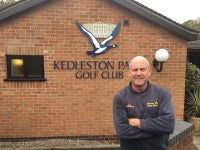
The course at Kedleston Golf Club opened for play in 1947, having moved from the Markeaton Golf Club, which is now the site of Derby University, Kedleston Road Campus. The expansion of Derby during the 1930s led to its closure in 1938 when the area was earmarked for development. The Markeaton club had been formed in 1895 and was one of the founding clubs of the Derbyshire Union in 1913. When closure was imminent, the club commissioned respected course architect, James Braid, to design a course over mature parkland in the grounds of Kedleston Hall, 820 acres of parkland designed by the then little known architect and landscape gardener, Robert Adam, and now managed by the National Trust.
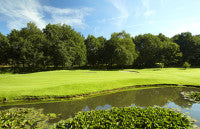
The onset of the Second World War, during which time Kedleston Hall formed one of the Y-stations used to gather Signals Intelligence via radio transmissions which, if encrypted, were subsequently passed to Bletchley Park for decryption, meant that construction could not begin until 1946. By this time, Braid had retired, so John Morrison and Harry Colt were invited to prepare a new course design. Two companies were approached to construct the course, J R Strutt Ltd (whose proprietor, John Strutt, was an old colleague of Braid) and Frank Harris Ltd. The machinery to maintain the course was obtained from the now defunct Markeaton Club. The course was one of the first to be created after the end of the war.
Kedleston Park has been further developed over the years whilst keeping its original layout. It is a respectable 6920 yards in length with a par of 72 from the Championship tees. The feature holes are the 151 yard, par 3, 7th and the 358 yard, par 4, 10th. The 5th green is protected to the left by a large copper beech tree, with the lake behind. A Robert Adam designed bridge provides a backdrop
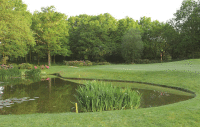
For over half of its history, Kedleston Golf Club has been tended by David Leatherland who joined the club straight from school in 1974, completing his City & Guilds in his formative years. He was promoted to Head Greenkeeper just four years later at the tender age of twenty.
Therefore, in 2014, he celebrated his fortieth anniversary, and it is testament to his love of the club that he continues to move with the times to produce such fine surfaces for golfers to play on.
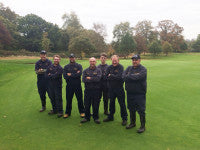
Apart from employing the services of agronomist Adam Newton and contractors for some of the heavy work, all work is carried out in-house. All staff are compliant with current legislation and, to keep up to date, are provided with ongoing training.
David is responsible for his own budgets. Machinery is generally purchased on a five-rear replacement basis, with Toro and John Deere machinery forming the main fleet. Toro machinery is purchased from local dealers P S Marsden, whilst the Jon Deere kit is bought from Henton & Chattell.
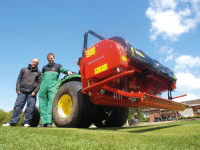
The greens are cut at 3mm in the summer, rising to 5mm in the winter. In addition to pencil tining, they are slit tined in the winter and scarified in spring and summer to 10mm.
Overseeding is an important part of David's regime. "We maintain a better sward by overseeding the greens with AberRoyal browntop bent, and the tees with a mixture of dwarf rye grasses. We use the browntop bent on greens and Lorina and Rex dwarf rye grass on tees."
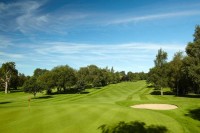
Asked if he uses temporary greens, David replied; "yes, but only if there's been a heavy frost. I would rather call them frost greens."
In addition to a very well maintained course, members have access to a comprehensive range of practice facilities, including a short game area, putting green, warm up nets, chipping area and a ten acre practice ground with distance markers and target greens. All these, along with the gardens, are tended by David and his team.
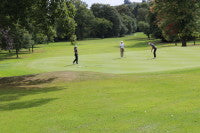
For the past two years, the club has been one of the hosts of the Alan Shearer Challenge, in which the now Match of the Day pundit plays a 'round' of golf at eighteen different courses across the country in one day in aid of his foundation which, in 2013, raised over £20,000. In September 2014, he arrived by helicopter, played just one hole - which he birdied - before heading back into the skies and on to his next course.
As well as various open competitions throughout the year, this is what makes David's job so enjoyable. "There's nothing better than having your work appreciated in this way," he says.
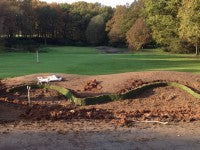
Winter projects saw work begin on bunker reconstruction last year, with twelve bunkers completed on the 1st, 10th and 11th. Wayne Freeman from Lakeland is employed to do the heavy earth work, with David and the team using their JCB 801.8 mini digger to install drainage lines and complete the more intricate work around the bunkers; "my favourite piece of kit," he confirms.
Work has already begun, this winter, on the bunkers on the 2nd, 3rd, 4th, 9th, 17th and 18th. "The 17th, in particular, is a massive project. It is being totally revamped. We will be working from drawing supplied by golf course architect, Tom MacKenzie. We aim to get as much work done as the weather will allow."
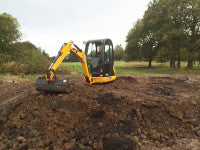
"We will also begin a programme of stripping, levelling and turfing tees but, with the changing weather patterns, we are finding that we are mowing much later into the year, and starting earlier the next, which impacts quite considerably on the time available."
"In fact, summer 2013 was a shocker. It was so wet through May and June that we struggled to keep the course open at times. Fortunately, the USGA greens coped well and, as you can see from the pictures, the course generally recovered well."
Where pests and diseases are concerned, David confirms that they do not suffer from specific disease outbreaks and that any spraying required is, again, carried out in house.

The flora and fauna on and around the course is a high priority and a large area of the park is a designated Site of Special Scientific Interest, which is carefully managed to protect wildlife. As a result, deadwood and trees remain where they fell to provide habitats for all sorts of animals, insects and fungi.
The Kedleston Park Golf Club Ecology Group was formed in December 2003 as part of the R&A's encouragement to golf clubs to become more environmentally sustainable. "Initially, we made and erected several nest boxes, designed to attract various species of birds. We also surveyed the flora and fauna to determine what we had around the course."

"We set up feeding stations for the birds and try to keep them stocked, resulting in many interesting species being seen at them, including Great and Lesser Spotted Woodpeckers, Nuthatch and Goldfinch. A total of 116 species had been recorded in the area at the end of 2012."
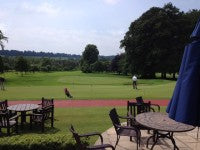
"We have arranged for a programme to eradicate about five areas of Japanese Knotweed on the course, with the help of the Mackworth and Markeaton Brook Project, and with no cost to the club. That project has also funded otter holts with which we assisted."
"The Ecology Group is available to advise the club on any matter relating to the local ecology and keeps close associations with other organisations, such as Derbyshire Wildlife Trust, RSPB, National Trust and the Mackworth and Markeaton Brook Project."
He may well be a rare breed himself having worked for one club all his life. Pitchcare congratulate him on this achievement.
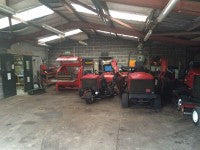
- Toro 5610 Reelmaster
- Toro 4000D Groundsmaster
- Toro 4300D Groundsmaster
- Toro 3100D Sidewinder x 2
- John Deere 2500E Hybrid x 2
- John Deere 2500E
- John Deere 365 gangmower
- John Deere 4310 tractor
- John Deere 3520 tractor
- Ford 2120 tractor
- JCB 801.8 digger
- Dennis pedestrian mower
- Pro Spreader
- Wiedenmann GXi HD Terra Spike
- Sisis Rotorake
- Sisis Star Tiner
- Multi Slitter
- Bernhard Angle Master 1000
- Bernhard Express Dual 3000
- Stihl Blowers x 2
- Stihl Chainsaws x 2
- Stihl Strimmers x 2
- Flymo hover mower
- Greens Iron 3900
- Tornado Blower
Machinery servicing is carried out in house by the team's greenkeeper/mechanic.
